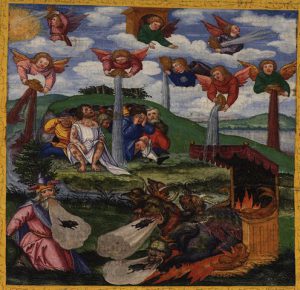 When most Christians think about the book of Revelation, they think about the book as a prophecy of the end events and the second coming of Christ. They may or may not realize that even futurist interpreters disagree over which parts of Revelation describe events that began in the past and continue until the second coming of Christ, that is, the “already” aspects of the book. This disagreement is one of the factors that separate futurists into several camps, including some amillennialists, dispensational premillennialists, and historic premillennialists. In the next few posts, we will look at each of these camps and see how they represent different varieties of a futurist approach to the book of Revelation.
When most Christians think about the book of Revelation, they think about the book as a prophecy of the end events and the second coming of Christ. They may or may not realize that even futurist interpreters disagree over which parts of Revelation describe events that began in the past and continue until the second coming of Christ, that is, the “already” aspects of the book. This disagreement is one of the factors that separate futurists into several camps, including some amillennialists, dispensational premillennialists, and historic premillennialists. In the next few posts, we will look at each of these camps and see how they represent different varieties of a futurist approach to the book of Revelation.
G. K. Beale: An Amillennialist and Example of a Moderate Futurist Approach1
G. K. Beale is a good example of an amillennialist who is at least somewhat of a futurist.2 According to him, the judgments associated with the first four seals (Rev. 6:1-8), the first six trumpets (8:6-9:21), and the first five bowls (16:1-11) began to occur after the ascension of Christ to heaven (12:5) and continue until the great day of God’s wrath (6:17). The great day of God’s wrath occurs at the end of time when Christ comes back. Consequently, the judgments associated with the end and the second coming of Christ include the sixth and seventh seals, the seventh trumpet, and the sixth and seventh bowls (146-48). Similarly, the three and a half year reign of the Beast (Rev. 13) is a symbolic time period. It begins with the ascension and exaltation of Christ (12:5-6) and continues until Christ defeats the Beast (Rev. 19). Other futurists might agree with aspects of Beale’s interpretation up to this point, but would generally associate more of Revelation with the future, that is, the final events and the second coming of Christ.
In addition, Beale’s view of the millennium clearly separates him from other futurists. Amillennialists, like Beale, have a distinctive interpretation of the millennium (20:1-6). They see the millennium as spanning the same time period when most of the judgments and the reign of the Beast occur. The millennium is a symbolic time period that begins with the exaltation of Christ. It continues until Satan is released from the abyss to gather his troops to fight against the armies of Christ. This means that Revelation 20:7-10 is a second presentation of the events of Revelation 19:17-21 (1028). Thus, the millennium is already underway. Christians already enjoy a spiritual resurrection and are ruling with Christ in heaven (996-7). In contrast to this view, other futurists see the millennium as a 1,000 reign of Christ that takes place in the future.
Notes:
1 References in this post are to G. K. Beale, The Book of Revelation: A Commentary on the Greek Text (The New International Greek Testament Commentary; Grand Rapids: Eerdmans, 1999).
2 Not all amillennialists are futurists (some are idealists). Beale actually claims to be following a modified idealist approach, because he wants to leave adequate room for “a final consummation in salvation and judgment” (49).
Other Sources:
These paragraphs represent an edited portion of my book:
Paul Hoskins, The Book of Revelation: A Theological and Exegetical Commentary, pp. 32-33 (these pages provide further sources and footnotes that I have omitted above).

